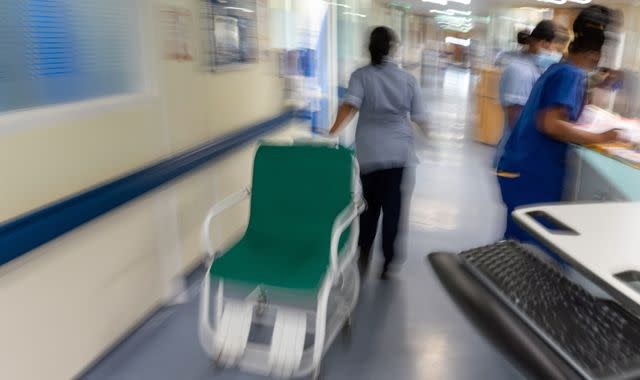NHS England waiting list falls with 6.44m on hold for routine treatment

The number of people in England waiting to start routine hospital treatment has fallen slightly, figures show.
An estimated 6.44 million were waiting to start treatment at the end of October, down from 6.5 million in September.
In terms of actual appointments - which include individuals who are waiting for more than one treatment - the waiting list also decreased.
An estimated 7.71 million treatments were waiting to be carried out at the end of October, down from a record 7.77 million treatments at the end of September, according to NHS England.
However, the appointment figure remains 3 million higher than it was before the COVID pandemic, and more than triple the 2.55 million in October 2010.
NHS national medical director, Professor Sir Stephen Powis, praised NHS staff for "pulling out all the stops to deliver for patients" despite "ongoing pressures".
"It is great to see clearly that hard work reflected in today's figures," he said.
"With the overall waiting list for elective care coming down, ambulance response times faster than both last month and the same time last year, as well as hundreds of new staff joining the emergency care workforce ahead of winter, this progress is excellent."
However, he said that the NHS still faced a "challenging winter on a number of fronts".
He added: "Our staff will once more be prioritising urgent and emergency care to protect patient safety and ensure those in life-saving emergencies can receive the best possible care, and the public can continue to play their part by using NHS services in the usual way - calling 999 in an emergency and using NHS 111 for other health conditions, and by getting their flu and Covid jabs if eligible."
Long wait list increases slightly
The number of people waiting more than a year to start routine hospital treatment at the end of October was also down, according to the NHS England figures.
A total of 377,618 people in England had been waiting more than 52 weeks to start routine hospital treatment at the end of October - down from 391,122 at the end of September.
The Government and NHS England have set the ambition of eliminating all waits of more than a year by March 2025.
Meanwhile, the number of people waiting more than 18 months to start routine hospital treatment went up to 10,506 - an increase of 3% compared to the 10,201 figure recorded in September.
The Government and NHS England set the ambition of eliminating all waits of more than 18 months by April this year, excluding exceptionally complex cases or patients who choose to wait longer.
In terms of cancer, the number of people who waited longer than 28 days to either confirm or rule out cancer after an urgent GP referral also dropped to 28.9% - down from 30.3% last month.
However, that was still above NHS England's 25% target - which has only been met once since it was introduced in April 2021.
Meanwhile, 36.9% of those starting treatment received their urgent referral more than two months prior - slightly higher than the 36.7% last month but more than double the service's 15%.
Ambulance wait times down slightly
Average ambulance wait times also fell by eight seconds for the most serious and life-threatening of incidents (Category 1) - down to eight minutes and 32 seconds in November from eight minutes and 40 seconds in October.
The figure is also nearly a minute down from the nine minutes 26 seconds last year - but remains well above NHS England's seven-minute target for Category 1 calls.
Wait times for Category 2 incidents - which include heart attacks and strokes - were also down slightly on last month, but still well above target.
The average wait time for a Category 2 call-out was 38 minutes 30 seconds last month, down more than three minutes from the 41 minutes and 40 seconds in October and 10 minutes better than the 48 minutes and 10 seconds of November last year.
However, it remained well above the target time of 18 minutes for Category 2 calls.
Read more from Sky News:
CCTV shows missing Norwich mother's last known movements
Tesco recalls Christmas dinner favourite over moth fears
For Category 3 calls - those regarded as urgent but not life-threatening - the average wait time was two hours, 16 minutes and 47 seconds on average last month.
That was 15 minutes better than last month and 26 minutes better than the same month last year.
Meanwhile, the data shows handover times have improved since the previous month, averaging 35 minutes and four seconds, down from 37 minutes and 33 seconds in October.
Earlier, the Prime Minister said the government would "keep a close eye" on ambulance delays when asked how bad they would get.
A&E figures released
In terms of A&E, some 69.7% of patients in England were seen within four hours last month, down from 70.2% in October, according to the figures.
The figure hit a record low of 65.2% in December 2022.
Meanwhile, the number of people waiting more than 12 hours in A&E departments in England from a decision to admit to actually being admitted was 42,854 in November, down slightly from 44,655 in October.
Click to subscribe to the Sky News Daily wherever you get your podcasts
The figure also hit a record 54,573 in December 2022.
By contrast, the number waiting at least four hours from the decision to admit to admission has risen slightly, from 144,926 in October to 146,272 in November.
However, this was against a backdrop of the second-highest number of 2.16 million people having visited last month - equivalent to 72,071 people every day.
That is the second-highest number ever recorded for November and the eighth highest for any month on record, and a slight increase from 71,601 a day in October.


